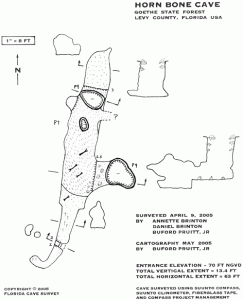By Buford Pruitt, Jr.
Annette and Danny Brinton, James Brown, Peggy Young and I visited some of the Archer Caves on April 9, 2005. Our primary goals were to visit Watch Cave and survey Possum Pipes Cave. James and Peggy live nearby and were interested in seeing both caves for the first time, and the Brintons and I were planning to survey Possum Pipes. Sean Roberts had intended to join us to finish the survey of Watch Cave but was unable to do so.
We met at Peggy’s house and walked south to the area where Watch Cave is located and spent a little while searching for it. I had forgotten a few details of the route, but when a flash of memory returned I was able to walk directly to it. I had told everyone that SRT would not be necessary so no one brought SRT gear, but I was wrong, SRT is indeed needed, so I didn’t get to show them the cave. Oh well.
Retracing our steps, we hiked back to Possum Pipes and, yep, had a little trouble re-finding that cave, too. But find it we did and we all explored the entrance area of the cave. At that point Peggy and James left us as they had other plans for the remainder of the day. I pulled out my surveying gear and we began the survey, but we didn’t get far. I had only sketched the entrance area and we had surveyed 5 stations when it became apparent that the remainder of the cave had sumped. Oh well.
There was nothing we could do but go looking for a cave with AIR in it, so we wandered around and found six other karst features worth noting. One, named Not Today, is a 19ft pit requiring SRT gear, which as I said we didn’t have that day.
Another feature is a solution pipe plastered with slick mud that inspired me to name it Mud Pipey, sort of after Mudpuppy (Peter Michaud), the well-known TAG caver. Mud Pipey is a narrow solution pipe averaging perhaps 2 feet wide or less from the surface to about 10 feet down, at which point it has a very tight restriction that could be composed of either mud or bedrock. We determined that we would need SRT gear to descend to it in order to determine which.
The last hole in the ground we checked out was a small joint-controlled cave with two entrance pits and a skylight. It met the Florida Cave Survey’s definition of a cave so we did a Grade 5 survey of it. The cave contained some vertebrate bones including turtle, deer, pig and the horn from a skull believed to be a water buffalo. Unsure if there is already a Horn Cave in Florida, we named it Horn Bone Cave to ensure a unique name. We were able to survey all but a single water-filled passage in 7 survey stations for a total horizontal length of 63ft and a vertical extent of 13 ft. The cave has a few nice formations, including some really pretty ones that Danny found in a tiny alcove in the ceiling of the southern passage that you have to climb up to in order to see.
Fortunately, all the caves and pits mentioned are on the Goethe State Forest property and therefore will be protected for the foreseeable future.


